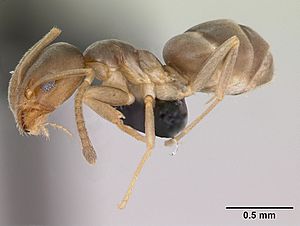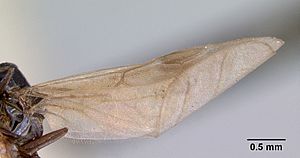Doleromyrma darwiniana facts for kids
Quick facts for kids Doleromyrma darwiniana |
|
|---|---|
 |
|
| Scientific classification | |
| Subspecies | |
|
Doleromyrma darwiniana is a type of ant that lives in Australia and has also been found in New Zealand. It was first described by a scientist named Forel in 1907. These ants usually build their nests in the soil or under rocks and logs. They are quite small, growing to be about 2 to 3 millimeters long. This ant species lives in small groups and prefers to eat foods rich in protein. Some people also call this ant the "brown house ant" or "Darwin's ant." In places like New South Wales, Australia, it's sometimes seen as a small pest in homes.
Contents
What Does This Ant Look Like?
How to Identify Darwin's Ant
Adult male Darwin's ants have wings. The Queen ants are a bit bigger, about 5 millimeters long. The worker ants are all the same size and shape, which is called Monomorphic. A worker ant is usually 2 to 3 millimeters long and is mostly brown. Its head is a darker brown, while the rest of its body is a lighter brown.
This ant looks a lot like another ant species called the Argentine ant (Linepithema humile). But there's a cool trick to tell them apart! If you crush a Darwin's ant, it gives off a distinct musty smell. They have antennae with twelve parts.
Their mouthparts, called mandibles, have 4 or 5 tooth-like parts that help them grab and crush food. The front part of the ant's head, called the clypeus, has hairs that curve downwards.
The ant's body has different sections. The first main body segment, called the propodeum, is lower than the back of its head. The ant's "waist," known as the petiole, looks like it leans forward. The last part of its body, the gaster, is raised up and hides the petiole when you look at the ant from behind.
Where Do Darwin's Ants Live?
Home in Australia
Darwin's ant is originally from Australia. You can find them in many parts of Australia, including Victoria, South Australia, Western Australia, New South Wales, Tasmania, and even along the coast of the Northern Territory.
Found in New Zealand
These ants have also been found in New Zealand, especially in coastal areas like Christchurch and Lyttelton. They've also been spotted in Auckland, Hawkes Bay, and Northland. Because they are attracted to port areas, they've been discovered in cities like Napier, Blenheim, Whangarei, Nelson, and Mt Maunganui.
What Do They Eat?
Darwin's ants are like generalists, meaning they can eat many different things. They act as both hunters and scavengers. This means they will hunt other insects, but they also eat food scraps they find.
They can be a pest because they love sugary foods. You might find them in kitchens, eating sweets, jam, honey, or cakes. They are also attracted to damaged fruit in orchards. There's a concern that they might become a problem in places where food is made in factories.
Darwin's ants also enjoy a sweet liquid called honeydew. This honeydew is made by tiny insects like mealybugs and aphids that feed on plant sap. The ants will "tend" to these insects, protecting them, in exchange for the honeydew.
Who Are Their Enemies?
Scientists don't have much information about what animals eat Darwin's ants or what parasites they might have. However, because they hang around rubbish and tend to aphids and mealybugs (which can carry diseases), it's possible they could spread germs.
A study showed that Darwin's ants can take over areas where native New Zealand ants live. For example, in places where Darwin's ants were found, other native ants like the common Southern ant (Monomorium antarcticum) were not present.
Other Cool Facts
Even though Darwin's ants are generalists and can be pests, they cannot sting you, and their bite is not very strong.
In the winter, smaller groups of these ants sometimes join together to form bigger colonies. This helps them survive the colder weather. Then, in the summertime, they separate again.
The special musty or greasy smell that helps identify them when crushed can also be noticed if there's a very large group of them nearby.
See also
 In Spanish: Doleromyrma darwiniana para niños
In Spanish: Doleromyrma darwiniana para niños


